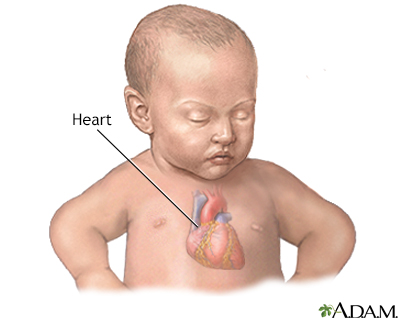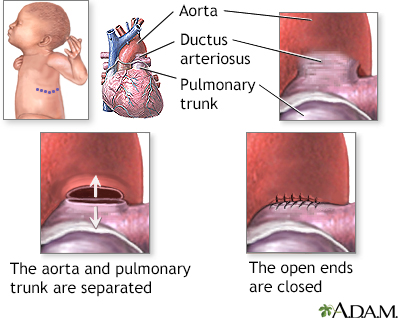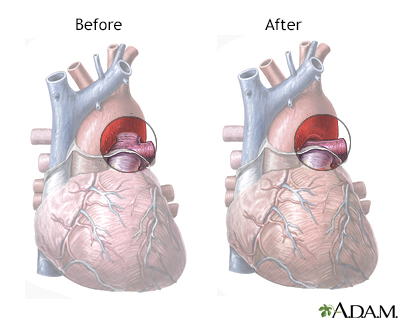Patent ductus arteriosis (PDA)
Normal Anatomy
|
|
The heart pumps blood throughout the body. It is located in the thorax.
|
Indications
|
|
The type and timing of surgical repair depends on the child's condition and the type and severity of heart defects.
In general, symptoms that indicate that surgery is needed are:
- Difficulty breathing because the lungs are wet, congested, or fluid-filled (congestive heart failure)
- Problems with heart rate or rhythm (arrhythmias)
- Excessive work load on heart that interferes with breathing, feeding, or sleeping
|
Procedure
|
|
An incision may be made through the breastbone (sternum) and between the lungs (mediastinum) while the child is deep asleep and pain-free (under general anesthesia). For some heart defect repairs, the incision is made on the side of the chest, between the ribs (thoracotomy) instead of through the breastbone. Heart lung bypass is used to support the child during the procedure. Tubes are used to re-route the blood through a special pump that adds oxygen to the blood and keeps it warm and moving through the rest of the body while the repair is being done.
|
Aftercare
|
|
Most children need to stay in the Intensive Care Unit for 3 to 7 days and stay in the hospital for 5 to 14 days. By the time the child is transferred out of the intensive care unit, most of the tubes and wires have been removed and they are encouraged to resume many of their daily activities. At the time of discharge, the parents are instructed on activity, how to care for the incision and how to give medications their child may need to take such as Digoxin, Lasix, Aldactone and Coumadin. The child needs at least several more weeks at home to recover.
|

Review Date:1/23/2023
Reviewed By:Mary C. Mancini, MD, PhD, Cardiothoracic Surgeon, Shreveport, LA. Review provided by VeriMed Healthcare Network. Also reviewed by David C. Dugdale, MD, Medical Director, Brenda Conaway, Editorial Director, and the A.D.A.M. Editorial team.
The information provided herein should not be used during any medical emergency
or for the diagnosis or treatment of any medical condition. A licensed medical professional
should be consulted for diagnosis and treatment of any and all medical conditions. Call 911
for all medical emergencies. Links to other sites are provided for information only -- they
do not constitute endorsements of those other sites. © 1997-A.D.A.M., Inc. Any duplication or distribution of the information contained herein is strictly prohibited.
The Agency for Health Care Administration (Agency) and this website do not claim the information on, or referred to by, this site is error free. This site may include links to websites of other government agencies or private groups. Our Agency and this website do not control such sites and are not responsible for their content. Reference to or links to any other group, product, service, or information does not mean our Agency or this website approves of that group, product, service, or information.
Additionally, while health information provided through this website may be a valuable resource for the public, it is not designed to offer medical advice. Talk with your doctor about medical care questions you may have.




